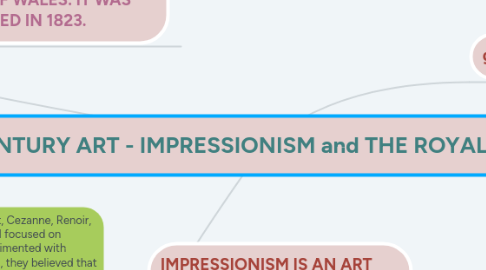
1. IMPRESSIONISM IS AN ART MOVEMENT ORIGINATED IN FRANCE IN 1850. THE ARTISTS REJECTED THE CONVENTIONAL RULES OF PAINTING AND ORGANISED INDEPENDENT EXHIBITIONS
1.1. ARTISTS: Monet, Manet, Cezanne, Renoir, Pizzarro, Degas. They all focused on ordinary life, they experimented with complementary colours, they believed that things were just a mass of colours and lights.
1.2. THE TERM WAS COINED BY THE ART CRITIC LEROY, WHO STARTING FROM A MONET'S WORK CALLED 'IMPRESSION, SUNRISE'
1.3. MAIN FEATURES: small but visible brush strokes. the subject maters are ordinary, greta importance is given to light
2. THE ROYAL PAVILION, KNOWN AS THE BRIGHTON PAVILLON IS A ROYAL RESIDENCE IN BRIGHTON. it was built in 3 stages starting in the mid 1780s by GEORGE PRINCE OF WALES. IT WAS COMPLETED IN 1823.
2.1. PRINCE GEORGE WENT TO BRIGHTON AS IT WAS ADVISED BY HIS DOCTOR TO BENEFIT FROM BRIGHTON'S MILD CLIMATE AND TO TRY SOME SEA WATER TREATMENT.
2.1.1. He was an extravagant man with passion for art, fashion, architecture and music. WHEN HE BECAME PRINCE REGENT he decided to change his marine pavilion into an ORIENTAL PALACE richly influenced by Chinese art.
2.2. 3 ROOMS are the most impressive:
2.2.1. MUSIC ROOM
2.2.1.1. COLORED WITH GOLD CANVASES IN CHINOSEIRE STYLE
2.2.2. THE BANQUETING ROOM
2.2.2.1. WITH ITS A SPECTACULAR CHANDELIER 30 FT HIGH WEIGHING A TON
2.2.3. THE GREAT KITCHEN
2.2.3.1. IT WAS INNOVATIVE AND MODERN FOR THAT TIME . constant water supply, latest heating technology, impressive ventilation and illumination system
2.3. WAR TIME
2.3.1. During WWI it was used as hospital for Indian soldiers. The interiors were altered but the resonation which stared in 1920 had to be interrupted as WWII broke out. Work started again in 1945 and it can be said that has continued ever since.
3. general ideas
3.1. it is called the age of romanticism
3.2. artists focused on individual expression and strong emotions
3.2.1. emotions were exaggerated and ranged from melancholy, despair, feat, hope and lodging
3.3. SUBJECT MATTERS : wild nature, which was beautiful and beyond human control
3.4. it developed in France Germany and England
3.4.1. Turner and Constable were English artists and they focused on nature
3.4.2. the germans concentrated more on folklore
3.4.3. the French described dramatic events

